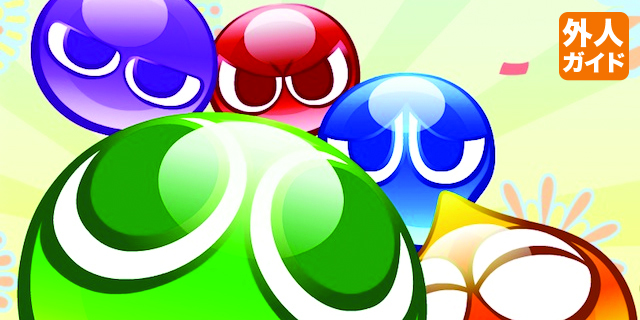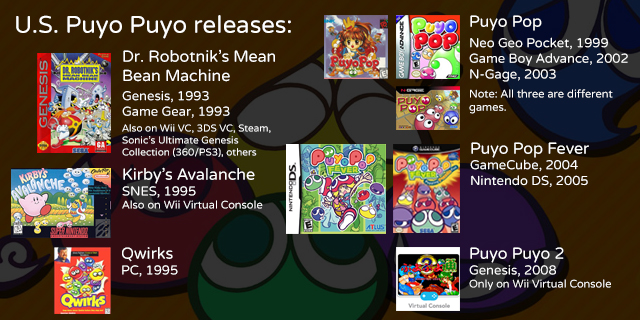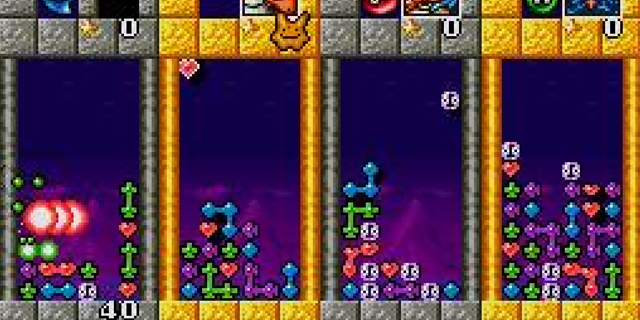
The just-announced Puyo Puyo Tetris may seem like a bizarre anomaly to some in the West. Even to those who’ve played one of the localized Puyo games, it still seems weird that it could share top billing with the king of the puzzle genre.
In Japan, it’s… still weird, but considerably less so.
First, though, the obligatory history lesson. See how the little pieces look vaguely like Slimes? That’s no accident. Puyo Puyo was itself a spinoff of a Dragon Quest-like JRPG called Madou Monotogari. Puyo are the game’s base-level Slime equivalent, and the series barely made a blip on the industry radar. (After a long hibernation, the franchise is being revived on the Vita, and it’ll be the first to get a Western release courtesy of Aksys!)
Even though Madou Monotogari didn’t make a big splash, Puyo Puyo certainly did. It’s seen release in one form or another on virtually every platform since 1991, and even survived the demise of original developer Compile when it was adopted by Sonic Team ten years later. There have been a few variations over the years, but the basic formula has stayed the same: connect four or more of one color, and try to chain more together when those disappear and the pieces above them fall.

The series is generally known as Puyo Pop in the West, though the earliest (and most widespread) releases were obscured by licenses on this side of the Pacific. Yes, I’m talking about both Dr. Robotnik’s Mean Bean Machine and Kirby’s Avalanche. Both are based on the first version of Puyo Puyo, and thus have the purest version of the series’ mechanics. It finally stepped out on its own here in 1999… on the Neo Geo Pocket Color. Ambitious! Then the Game Boy Advance, then the N-Gage. The series made its last splash in America with Puyo Pop Fever, released here on GameCube and DS.
But the releases didn’t stop in Japan. There were seven main releases and a whole host of spinoffs and anniversary editions, and each one showed up on any system that was active at the time. There are a lot of interesting Puyo stories, from the secret Game Gear translations and strategy spinoffs to the Tiger LCD games and eShop experiments, but let’s focus on just this one.
Puyo Puyo was as formative for Japanese puzzle games as Tetris in many ways, but most prominently because it defined the swing-based dynamics and competitive focus that would become a mainstay in the hemisphere. We’ve seen it trickle in over here from time to time, but generally, Western puzzle games are about solitary focus. They’re about getting to higher levels in Tetris, or building up a high score in Bejeweled. Japanese puzzle games are about head-to-head play and reflexes. You see this in Magical Drop, in Puzzle League, in Bust-a-Move.

This whole movement was born in the arcade. You never saw many Western puzzle games take quarters from misguided youth. Japanese puzzle games? They’re just as prevalent as fighters, and they’re designed very similarly. If you think of Puzzle Fighter as some weird aberration and not the most logical genre mash-up in the history of games, you just aren’t paying attention. There’s give-and-take. Combos for extra damage. Best-of-three matches and special abilities. Just none of those pesky quarter-circle moves.
Though this is the first mash-up of the two actual franchises, the two styles have intersected before. Tetris Battle Gaiden, a 1993 Japan-only Super Nintendo release, was a Tetris game, sure, but it had a Japanese animation style, silly characters and powerful attack moves. It’s difficult to find these days, but where you do find it, you can be sure to find a dedicated following nearby.
This new project, though, is different. It’s pure Tetris against pure Puyo, with some crazy alternating between the two. Who knows whether it’ll actually work very well, but with the popularity of Tetris, it has a shot at localization. (Even if it doesn’t, the region-free PS3 and Vita are release platforms, and the language barrier should be quite low.)
This situation reminds me a lot of when Street Fighter X Tekken was first announced. Much like Tetris, Street Fighter is an international success. Much like Tekken, Puyo Puyo is a largely-Japanese phenomenon. What’s next? Guitar Hero vs. Taiko Drum Master? Suikoden Final Fantasy? Grand Theft Auto X Yakuza? (Actually, I’d play all of those.)
If you haven’t played a Puyo game before, you have a few options. My recommendation? Find the Atlus-localized DS version of Puyo Pop Fever if you can, for its portability and great eight-person single-card play. It may be tough, though. You can grab the Genesis version of Puyo Puyo Tsu as a Wii Virtual Console import title, and is best enjoyed with its original look and characters, even if the two licensed editions also make an appearance on the service. Neither of those working for you? At least you can play Mean Bean Machine on 3DS and Steam, as well as on the Sonic’s Ultimate Genesis Collection disc for 360 and PS3.



















